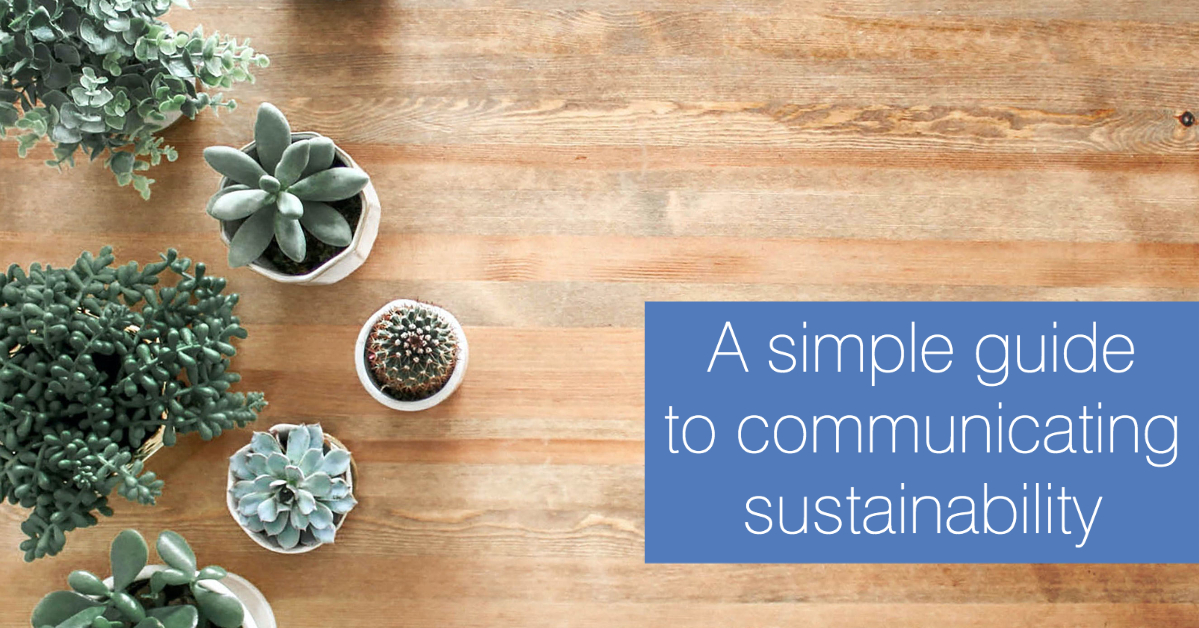A simple guide to communicating sustainability

Climate change, biodiversity loss and social inequality are frighteningly complex and interconnected problems. So how do you engage people with them in a meaningful way? Focus on your audience and keep it simple, writes Communication Manager Sarah Ford-Hutchinson.
Sometimes, I’m a terrible communicator.
Take this morning: I was writing you a blog on how to communicate sustainability like a pro. It was logical, well-referenced, and at 3000 words… generously written. I imagined you taking a break from your work or studies to read and absorb it, and making a plan to take those suggestions forward in your own life.
I grimaced when I remembered that this wasn’t what you asked for. You wanted a simple guide on how to communicate sustainability to your colleagues and peers; I was giving you an essay.
Forgetting your audience is a surprisingly common mistake in communications. It’s easy to get caught up thinking about what you want to tell them, rather than what they need or might be willing to receive.
So – being mindful that you’ve got lots of other things to think about right now – here is a simple guide to communicating sustainability.
If you want more information, rewatch my webinar: Crash course in communicating sustainability, May 2020.
1. Understand your audience
… and find an angle that will interest them. This seems really obvious, but it’s a common pitfall in many attempts to communicate and encourage behaviour change. Who is your audience, what are their core values, what do they see as their purpose, and what are their needs right now?
Understanding these will help you find the right method and moment to communicate sustainability. If protecting the environment doesn’t appear to be a core need or value of your audience, communicating on that basis is unlikely effective. Instead, non-environmental drivers may work better, as will linking sustainability to other issues they are passionate about or concerns they currently have.
For example, if financial stability is a current concern, offering sustainable options that are guaranteed to save costs will seem more attractive. The Sustainable Campus Fund is a great tool for securing extra funding if upfront costs are an issue.
If group cohesion is an issue, suggesting team bonding activities may help group members see each other in a different light. The Sustainability Awards is a fantastic way of encouraging staff and student groups to work together in a creative way to improve their University environment, whether that’s through resource efficiency, active travel, energy-saving, or health and wellbeing.
Who is your audience, what are their core values, what do they see as their purpose, and what are their needs right now?
2. Explain what you mean by sustainability
Sustainability means a lot of different things to different people, so explain to your audience the elements of sustainability you’re talking about. The UN’s Sustainable Development Goals are a great starting point for framing discussions; they set out 17 interconnected things that must happen for the world to have peace and prosperity for both people and the planet, now and in the future. Decide which element(s) of sustainability are integral to the thing you are trying to communicate, and explain them to your audience to a depth that you think they’ll be interested in.
For audiences will little prior knowledge of what sustainability is, topics like plastic pollution and ‘active’ travel (walking and cycling) are likely to be things they will understand and be able to relate to. For audiences with a good grasp of climate change, biodiversity loss or social inequality, linking these issues to other global sustainability concerns or the concerns of your audience can help frame a really interesting discussion.
For info on what the University is doing on various aspects of sustainability, check out the topics the University works on, the Social Responsibility and Sustainability 2018-19 Report, or Strategy 2030’s focus on Social and Civic Responsibility.
3. Harness the power of positivity
Humans are hard-wired to respond to potential threats. We listen up when we hear words like ‘pandemic’, ‘cancer’ and ‘bomb’ because we understand that these have the potential to have a profoundly negative impact on us.
As climate change, biodiversity loss and social inequality aren’t always seen as immediate threats, we don’t feel the same urgent need to respond. Sadly it often takes a local manifestation of these – such as flooding, crop failure or homelessness – to bring the issue home for us.
While we’re drawn to bad news, we are also easily overwhelmed by it, resulting in disengagement. Stories of positivity are much more palatable, and in times of crisis (like the current COVID-19 pandemic) are extremely nourishing for society, often resulting in positive behaviour change.
Positive News is a great example of ‘constructive journalism’ – telling solution-focused news to balance out the negative and conflict-based stories we see every day. Our own department’s communications almost always focus on positivity: see our blog and Sustainability Awards case studies for some uplifting examples.
Focus on the positives that sustainability can bring – particularly at a local or individual level – and your audience may be more willing to listen.
Stories of positivity are extremely nourishing for society
4. Be creative
In an age where information washes over us constantly, it pays to be a little different. Once you know who your audience is and what interests them, think creatively about how you will engage them with your topic.
Busy and stressed colleagues might appreciate a wellbeing break during which you teach them how to reduce waste by making their own beeswax wraps. Help students understand how sustainability relates to their field of study by inviting course alumni who’ve taken their career in that direction: such as engineering graduate Olivia Sweeney, ethical buyer at Lush and listed in the Top 100 Influential Women in Engineering, or Veterinary Medicine graduate Cal Major who was the first person to stand up paddleboard from Land’s End to John O’ Groats, raising awareness of ocean plastics in local communities along the way.
Test your creative ideas out with small groups of people, get feedback, then improve and upscale. If you’re unsure where to start, ask around for ideas; many people relish the opportunity to help with a bit of creative thinking.
5. Be kind
Living a more sustainable life can be a virtuous pursuit, but making people feel guilty for not doing so is not something I’d recommend. While Blue Planet II had us collectively hang our heads in shame at the volume of plastic that ends up in the ocean – sparking millions of extra beach cleans and a really important global discussion on how to reduce plastic use – individual shaming is much more problematic. If you’re keen to engage your peers on an issue, it’s better to start by listening to their views and discussing more sustainable alternatives. Stand by their side – trial new products together or cook the same veggie or vegan recipes, and be honest in your assessments. We have lots of suggestions on our webpages for things staff and students can do to be more sustainable.
Urgently responding to climate change, biodiversity loss and social inequality is compatible with being compassionate; and it’s more effective to reach people based on their values and promote change from within, rather than simply doing it ‘because it’s the right thing’ or for fear of judgement.
To summarise, focus on your audience and be clear, positive, creative and kind, and you stand a really good chance of making a difference.
Sustainability needs good communicators, and you could be one of them.
Sarah Ford-Hutchinson is the Communication Manager in the University’s Department for Social Responsibility & Sustainability.





Recent comments